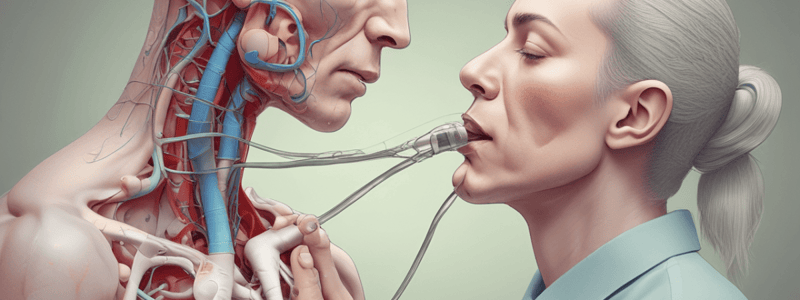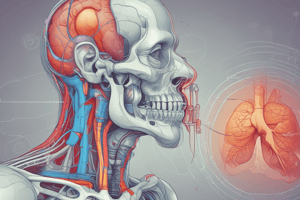Podcast
Questions and Answers
What is respiratory failure defined as?
What is respiratory failure defined as?
- The inability to maintain normal body temperature
- The inability to maintain either the normal level of delivery of O2 to the tissues or the normal removal of CO2 from the tissues (correct)
- The inability to maintain normal blood pressure
- The inability to maintain normal heart rate
What is tracheal tugging caused by?
What is tracheal tugging caused by?
- Normal airway resistance
- The position of the patient's head
- Abnormally high airway resistance (correct)
- Abnormally low airway resistance
What is the result of the same mechanism that causes tracheal tugging?
What is the result of the same mechanism that causes tracheal tugging?
- Pulsus Paradoxus (correct)
- Respiratory failure
- Emphysematous Habitus
- Tripod position
What is the benefit of the tripod position in respiratory mechanics?
What is the benefit of the tripod position in respiratory mechanics?
What is Emphysematous Habitus?
What is Emphysematous Habitus?
What is the result of the patient making their intrathoracic pressure much lower than ambient pressure?
What is the result of the patient making their intrathoracic pressure much lower than ambient pressure?
What is the primary indication of chronic left ventricular failure?
What is the primary indication of chronic left ventricular failure?
During labored inspiration, which muscles are used to increase thoracic diameter?
During labored inspiration, which muscles are used to increase thoracic diameter?
What is the significance of a clavicular lift of 5 centimeters or more on inspiration?
What is the significance of a clavicular lift of 5 centimeters or more on inspiration?
What is the characteristic movement of the abdominal wall during inspiration in a patient with diaphragmatic dysfunction?
What is the characteristic movement of the abdominal wall during inspiration in a patient with diaphragmatic dysfunction?
What is the best position to observe abdominal paradox in a patient?
What is the best position to observe abdominal paradox in a patient?
What is the term for the alternating use of the diaphragm and accessory muscles during inspiration?
What is the term for the alternating use of the diaphragm and accessory muscles during inspiration?
What is a sign of serious hypoxemia in a patient with respiratory failure?
What is a sign of serious hypoxemia in a patient with respiratory failure?
What is the characteristic breathing pattern of a patient with respiratory failure?
What is the characteristic breathing pattern of a patient with respiratory failure?
What is the purpose of pursed lip exhalation in a patient with respiratory failure?
What is the purpose of pursed lip exhalation in a patient with respiratory failure?
What is the term for the abnormal breath sounds heard in a patient with respiratory failure?
What is the term for the abnormal breath sounds heard in a patient with respiratory failure?
What is a sign of consolidation in a patient with respiratory failure?
What is a sign of consolidation in a patient with respiratory failure?
What is a sign of increased intra-thoracic pressure in a patient with respiratory failure?
What is a sign of increased intra-thoracic pressure in a patient with respiratory failure?
Which of the following is a sign of increased intra-thoracic pressure in a patient with respiratory failure?
Which of the following is a sign of increased intra-thoracic pressure in a patient with respiratory failure?
What is the term for the inward movement of the abdominal wall during inspiration in a patient with diaphragmatic dysfunction?
What is the term for the inward movement of the abdominal wall during inspiration in a patient with diaphragmatic dysfunction?
Which of the following is a sign of consolidation in a patient with respiratory failure?
Which of the following is a sign of consolidation in a patient with respiratory failure?
What is the benefit of the tripod position in respiratory mechanics?
What is the benefit of the tripod position in respiratory mechanics?
What is the term for the abnormal breath sounds heard in a patient with respiratory failure?
What is the term for the abnormal breath sounds heard in a patient with respiratory failure?
What is a sign of serious hypoxemia in a patient with respiratory failure?
What is a sign of serious hypoxemia in a patient with respiratory failure?
Flashcards are hidden until you start studying
Study Notes
Respiratory Failure
- Respiratory failure is not a disease, but the end result of various problems.
- It is defined as the inability to maintain normal delivery of O2 to tissues or removal of CO2 from tissues.
Signs and Symptoms of Respiratory Failure
- Dyspnea with abnormal breathing pattern (increased or decreased rate and depth)
- Nostril flaring on inspiration and pursed lip exhalation
- Accessory muscle use (evidenced by clavicular lift during inspiration)
- Abdominal paradox (inward movement of abdominal wall during inspiration, best seen in supine position)
- Cyanosis (central and/or peripheral)
- Abnormal breath sounds (bronchial or bronchovesicular sounds heard diffusely)
Adventitious Breath Sounds
- Stridor, rhonchi, and rales (wheezes and crackles)
- Tripping position (emphysematous habitus)
- Use of accessory muscles
- Evidence of consolidation (dullness to percussion and egophony)
- Pursed lip exhalation
- Lower rib retractions (Hoover's sign)
Other Signs of Respiratory Failure
- Altered mental status (sign of serious hypoxemia)
- Distended neck veins (JVD)
- Cyanosis (see Slide 31)
Tracheal Tugging
- Inward pulling of skin of the neck during inspiration due to high airway resistance
- Causes retractions (visible outline of ribs and sternum during inspiration)
- Pulsus Paradoxus (severe reduction in pulse strength during spontaneous inspiration) also occurs due to the same mechanism
Tripod Position (Emphysematous Habitus)
- Patient sits upright, leaning forward with head erect and hands on knees with arms braced
- Improves respiratory mechanics by giving diaphragm more room to expand and using gravity to assist downward movement
- Different from orthopnea (comfortable breathing only in upright position)
Clavicular Lift
- Visible rise of clavicles during inspiration due to use of accessory muscles
- 5 cm or more of clavicular lift on inspiration indicates severe airway obstruction
Abdominal Paradox
- Paradoxical inward movement of abdominal wall during inspiration due to diaphragmatic dysfunction (weakness, fatigue, or paralysis)
- Best seen when patient is supine
- Occurs when diaphragm is fatigued and becomes flaccid, and inspiration is performed by accessory muscles
Studying That Suits You
Use AI to generate personalized quizzes and flashcards to suit your learning preferences.



